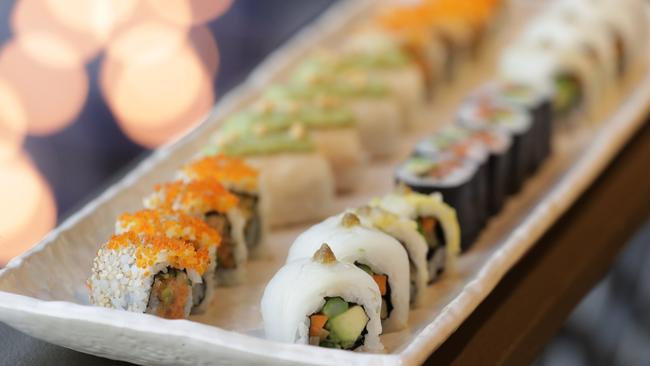How healthy is your favourite sushi?
YOU might think you are doing your body a favour when you opt for sushi over pizza, but one of our favourite lunch options might not be as healthy as you hope.

Health
Don't miss out on the headlines from Health. Followed categories will be added to My News.
SUSHI is universally considered a healthy meal to grab on the run. The range of foods often labelled as ‘sushi’ is wide, and can include sashimi itself as well as a range of rolls made with plenty of sugary rice and fried fillings. It is for this reason that not all sushi is created equal when it comes to nutrition. So if sushi is often on your list of healthy lunch options, here are the good and not so good choices.
Sashimi
Sashimi, or any type of raw fish that is sliced and served as individual pieces is an exceptionally strong choice nutritionally with just 30-40 calories per piece, as well as plenty of protein and long chain omega 3 fats. The thing to be mindful is that as some types of sashimi may come from large varieties of fish including ahi tuna which can be particularly high in mercury. Mercury can accumulate in the body’s tissues over time causing neurological dysfunction and as such sashimi should be consumed no more than 2-3 times each week.

Hand rolls
Often described as ‘sushi’, California rolls or hand rolls are generally made with sushi rice, fillings ranging from avocado, to fish to fried chicken and some seaweed. As the rice used to make sushi often contains added sugars to help it stick, the combination of rice and high fat fillings such as avocado, fried meat and mayonnaise can mean that a single hand roll can contain as much as 170 calories and as much carbohydrate as 2 slices of bread. Or a small lunch pack of 6 rolls, up to 300 calories and 50g of carbohydrates. For this reason, sticking to a small number of rolls, and brown rice options will help to improve the nutritional profile of the average sushi roll.
Edamame
Perhaps one of the best options on a Japanese menu, edamame is a protein and fibre rich option which adds much bulk to your favourite Japanese meal, minus the calories. With just 60 calories per pot of beans, adding a serve to your meal will significantly improve its nutritional profile.
Seaweed salad
Another nutrient rich addition, seaweed is a superfood in the world of nutrition as it added much needed iodine into our diet which is crucial to help our thyroid function optimally. It also contains next to no calories with a ½ cup serve adding just 20 calories to your meal.

Miso soup
A Japanese staple, miso is a made by fermenting soybeans with koji mould and is especially rich in nutrients, offering a range of vitamins and minerals as well as probiotics known to be particularly important for gut health. While miso is relatively high in sodium, containing up to 1000mg per serve, it is also low in calories with less than 100 calories per serve, and the health benefits associated with consuming it as part of a balanced Japanese meal outweigh any of the negatives.
Wasabi
When it comes to wasabi you can consume as much as you can tolerate to your hearts content. Packed with antioxidants known for their anti-cancer function, wasabi is virtually calorie free.
Tempura
The Americanised version of Japanese, if you take the word tempura to mean fried, whether it is fried vegetables, tempura sushi or seafood, tempura is a relatively high fat option compared to traditional Japanese cuisine. In the case of a California roll, the addition of tempura will almost double the calories, while a single serve of tempura prawns and vegetables will contain at least 20g of fat, most likely coming via a blended vegetable oil.
Soy Sauce
A staple with most Japanese dishes, the issue with soy sauce, even the small amounts we dip our sashimi into is that it is packed full of salt with a single tablespoon containing a 1/3 of our upper daily recommended into. For this reason go easy on the little fishes of soy and try and limit your intake to one per meal at most which is roughly 200mg of sodium per serve.
Noodles
Different cuisines mean different types of noodles and you may see udon, soba or ramen on offer. While sushi rice used in rolls may contain added sugars, noodles are not necessarily a better choice, thanks to the heavy calorie and carbohydrate load they contain per serve. For example, a small cup sized serve of noodles will contain at least the same amount of carbohydrates as two slices of bread and in many cases they will be cooked using extra oil so go easy on your portions.
Susie Burrell is a dietitian. Follow her on Facebook or Twitter.
Originally published as How healthy is your favourite sushi?







